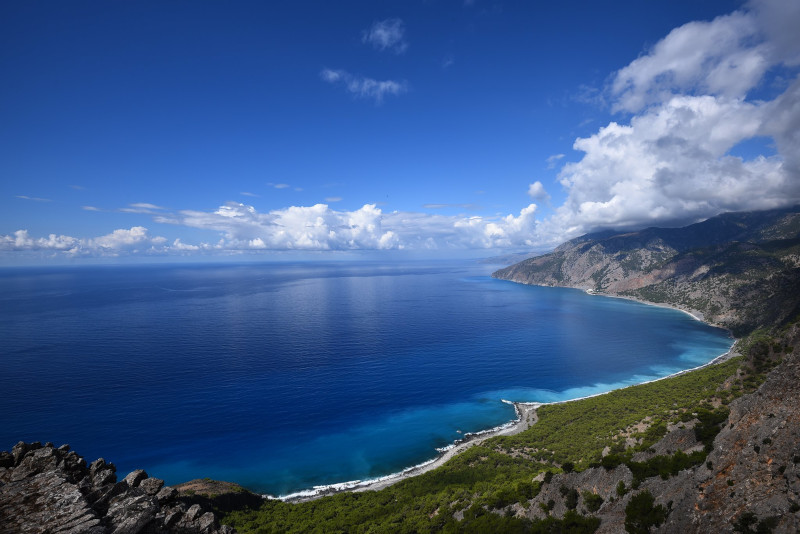
Crete Facts
- This breathtaking creation of time and geological processes remains best known by the english language common name of Crete. In the primary native language of the region it which it sits, however, the site’s also known by the title of Κρήτη.
- It’s currently unknown exactly when humans first discovered this amazing masterpiece of Nature. The oldest known references to the location in text, though, reach back to approximately the 18th century BC. Those entries referred to it simply as Kaptara.
- Archaeological evidence, however, extends this knowledge back even further. This indicates that the ancient Minoan civilization inhabited the island as far back as 2700 BC. At the time, it served as the center of that most advanced civilization in the region.
- Extending back into even more distant eras, though, the same type of indicators show knowledge of the site even as much as 130,000 years ago. It seems, however, that these ancient, primitive humans never established any permanent settlements on the island.
- In our modern era, though, the stunning Crete not only has a thriving population, but also serves as a leading tourist destination in its area. The sheer, pristine beauty of the site draws and captivates the visitor. The archaeological sites also attract interest.
- Yet, this popularity creates a complicated situation. The local government generally takes great care to maintain as much of the natural beauty that draws the tourists, of course. The very numbers that this attracts, however, could overwhelm such efforts.
Related Articles




Crete Physical Description
The startling beauty of Crete certainly captivates nearly all those fortunate enough to visit this geological gem. Yet, the site impresses for more than just that visual appeal. That’s true given the fact that it also boasts some fully respectable physical measurements.
The overall shape of the formation is comparatively elongated. It measures roughly 160 mi (257 km) from west to east. At even its widest point, though, the island only reaches 37 mi (60 km). Its narrowest point, however, comes in at no more than 7.5 mi (12 km).
The combination of its many fluctuations in diameter provides it with an appreciable total surface area. This equals approximately 3,260 sq mi (8,450 sq km). It also has a highly irregular coastline that extends fora remarkable stretch that totals 650 mi (1,046 km).
Inland, though, this wonder of natural processes displays more marvels to delight the viewer. Among these is the fact that entirre island has a largely mountainous nature. Surprising many, six separate groups of mountains tower over the rest of the gorgeous landscape.
These often quite different ranges include an astonishing 30 peaks whose summits reach or exceed 6,600 ft (2,012 m). Mount Ida stands supreme within the collection, however. Its mighty apex also looms over the surrounding terrain at an altitude of 8,058 ft (2,456 m).
Yet, the breathtaking Crete doesn’t stop there with its efforts to impress us. The presence of all these majestic peaks naturally creates a number of related features. These include numerous fertile plateaus, incredible valleys, caves, and even a number of gorges.
Multiple moderate-sized rivers even appear on this geological treasure. They include the Koiliaris, the Anapodiaris, the Almiros, among others. The island also possesses two naturally formed freshwater lakes. A third once existed, but it now connects to the sea.

Crete Location, Formation, and Ecology
The unearthly beauty that’s Crete formed in a region of globe already well known for its abundance of natural marvels. Indeed, the area where the site lies likely won’t surprise many of you. That’s because it formed off the shores of the continent of Europe.
Its location places it within the confines of the Mediterranean Sea. Sitting where it does there, the island rests roughly 99 mi (160 km) south of the mainland of the country of Greece. The same placement also puts the marvel about 62 mi (100 km) from Anatolia.
This stunning site owes its creation to the efects of tectonic movements, not volcanic activity. Research indicates that between 70 – 55 million years ago, three separate plates crashed together. The action forced a local area that had been under water to rise upward.
As this process continued, some volcanoes did form, but became extinct prior to the rise of human civilization. What’s now this island, and others nearby, broke apart around 8 million years ago. The site as we know it achieved its general form roughly 3 million years ago.
The captivating location hosts an abundance of both flora and fauna. Being isolated from the mainland, many of these followed different evolutionary paths than their relatives there. Peerhaps due to random chance, no native species dangerous to man exist.
Among the mammals to be found on Crete are indigenous varieties of wild goats, martens, weasels, rodents, and even a potentially native species of wildcat. Numerous types of birds, amphibians, and a few reptiles also appear. At least two sea turtles also visit.
Sadly, human activities over the centuries devastated most of the native forests. Yet, small numbers of trees remain, including several species. Flowers abound here, though. Along with mulitple types of wildlfowers, over 200 varieties of wild orchids exist here!
Features Sharing Its Region



Check out our other articles on 7 Magnificent West Coast Marvels, Marbled Polecat, Mississippi River, Great Rhododendron, Mountain Apollo, Giant Clam, Philippine Cobra









Leave a Reply